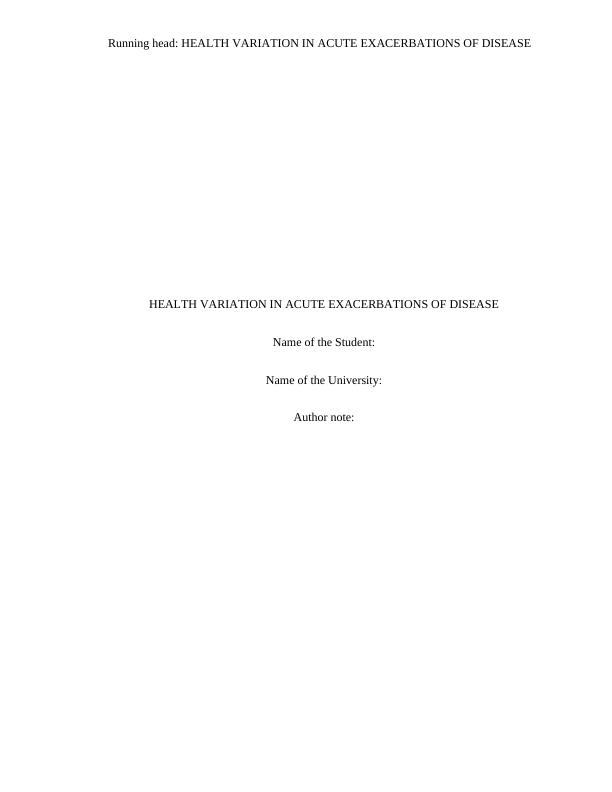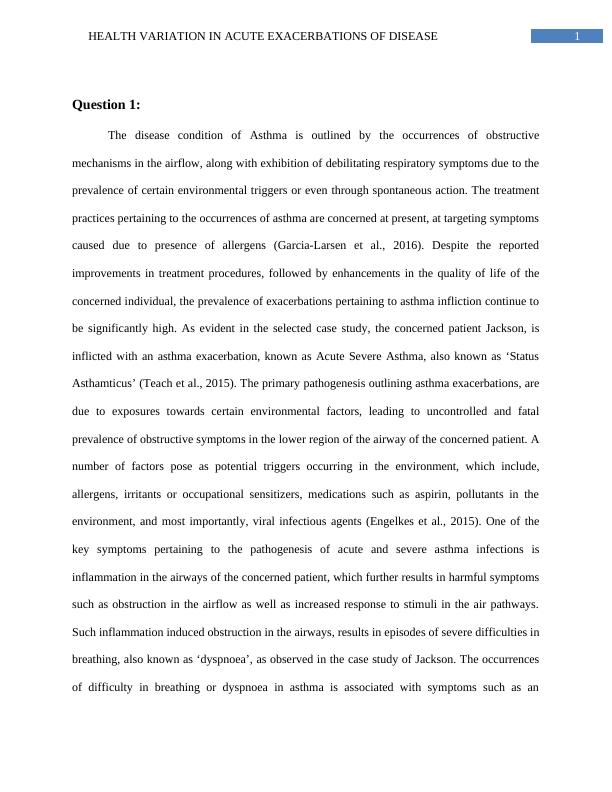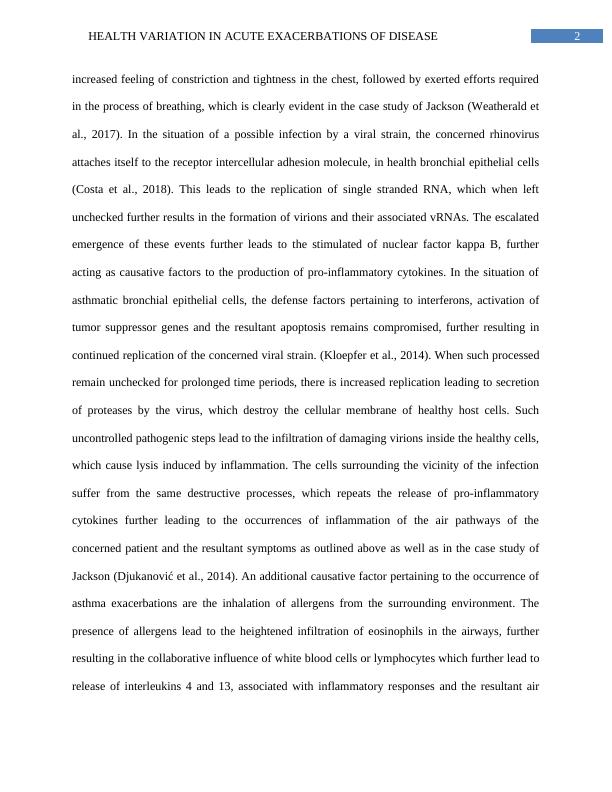Health Variation in Acute Exacerbations of Disease
Added on 2023-06-03
9 Pages2414 Words135 Views
Running head: HEALTH VARIATION IN ACUTE EXACERBATIONS OF DISEASE
HEALTH VARIATION IN ACUTE EXACERBATIONS OF DISEASE
Name of the Student:
Name of the University:
Author note:
HEALTH VARIATION IN ACUTE EXACERBATIONS OF DISEASE
Name of the Student:
Name of the University:
Author note:

1HEALTH VARIATION IN ACUTE EXACERBATIONS OF DISEASE
Question 1:
The disease condition of Asthma is outlined by the occurrences of obstructive
mechanisms in the airflow, along with exhibition of debilitating respiratory symptoms due to the
prevalence of certain environmental triggers or even through spontaneous action. The treatment
practices pertaining to the occurrences of asthma are concerned at present, at targeting symptoms
caused due to presence of allergens (Garcia-Larsen et al., 2016). Despite the reported
improvements in treatment procedures, followed by enhancements in the quality of life of the
concerned individual, the prevalence of exacerbations pertaining to asthma infliction continue to
be significantly high. As evident in the selected case study, the concerned patient Jackson, is
inflicted with an asthma exacerbation, known as Acute Severe Asthma, also known as ‘Status
Asthamticus’ (Teach et al., 2015). The primary pathogenesis outlining asthma exacerbations, are
due to exposures towards certain environmental factors, leading to uncontrolled and fatal
prevalence of obstructive symptoms in the lower region of the airway of the concerned patient. A
number of factors pose as potential triggers occurring in the environment, which include,
allergens, irritants or occupational sensitizers, medications such as aspirin, pollutants in the
environment, and most importantly, viral infectious agents (Engelkes et al., 2015). One of the
key symptoms pertaining to the pathogenesis of acute and severe asthma infections is
inflammation in the airways of the concerned patient, which further results in harmful symptoms
such as obstruction in the airflow as well as increased response to stimuli in the air pathways.
Such inflammation induced obstruction in the airways, results in episodes of severe difficulties in
breathing, also known as ‘dyspnoea’, as observed in the case study of Jackson. The occurrences
of difficulty in breathing or dyspnoea in asthma is associated with symptoms such as an
Question 1:
The disease condition of Asthma is outlined by the occurrences of obstructive
mechanisms in the airflow, along with exhibition of debilitating respiratory symptoms due to the
prevalence of certain environmental triggers or even through spontaneous action. The treatment
practices pertaining to the occurrences of asthma are concerned at present, at targeting symptoms
caused due to presence of allergens (Garcia-Larsen et al., 2016). Despite the reported
improvements in treatment procedures, followed by enhancements in the quality of life of the
concerned individual, the prevalence of exacerbations pertaining to asthma infliction continue to
be significantly high. As evident in the selected case study, the concerned patient Jackson, is
inflicted with an asthma exacerbation, known as Acute Severe Asthma, also known as ‘Status
Asthamticus’ (Teach et al., 2015). The primary pathogenesis outlining asthma exacerbations, are
due to exposures towards certain environmental factors, leading to uncontrolled and fatal
prevalence of obstructive symptoms in the lower region of the airway of the concerned patient. A
number of factors pose as potential triggers occurring in the environment, which include,
allergens, irritants or occupational sensitizers, medications such as aspirin, pollutants in the
environment, and most importantly, viral infectious agents (Engelkes et al., 2015). One of the
key symptoms pertaining to the pathogenesis of acute and severe asthma infections is
inflammation in the airways of the concerned patient, which further results in harmful symptoms
such as obstruction in the airflow as well as increased response to stimuli in the air pathways.
Such inflammation induced obstruction in the airways, results in episodes of severe difficulties in
breathing, also known as ‘dyspnoea’, as observed in the case study of Jackson. The occurrences
of difficulty in breathing or dyspnoea in asthma is associated with symptoms such as an

2HEALTH VARIATION IN ACUTE EXACERBATIONS OF DISEASE
increased feeling of constriction and tightness in the chest, followed by exerted efforts required
in the process of breathing, which is clearly evident in the case study of Jackson (Weatherald et
al., 2017). In the situation of a possible infection by a viral strain, the concerned rhinovirus
attaches itself to the receptor intercellular adhesion molecule, in health bronchial epithelial cells
(Costa et al., 2018). This leads to the replication of single stranded RNA, which when left
unchecked further results in the formation of virions and their associated vRNAs. The escalated
emergence of these events further leads to the stimulated of nuclear factor kappa B, further
acting as causative factors to the production of pro-inflammatory cytokines. In the situation of
asthmatic bronchial epithelial cells, the defense factors pertaining to interferons, activation of
tumor suppressor genes and the resultant apoptosis remains compromised, further resulting in
continued replication of the concerned viral strain. (Kloepfer et al., 2014). When such processed
remain unchecked for prolonged time periods, there is increased replication leading to secretion
of proteases by the virus, which destroy the cellular membrane of healthy host cells. Such
uncontrolled pathogenic steps lead to the infiltration of damaging virions inside the healthy cells,
which cause lysis induced by inflammation. The cells surrounding the vicinity of the infection
suffer from the same destructive processes, which repeats the release of pro-inflammatory
cytokines further leading to the occurrences of inflammation of the air pathways of the
concerned patient and the resultant symptoms as outlined above as well as in the case study of
Jackson (Djukanović et al., 2014). An additional causative factor pertaining to the occurrence of
asthma exacerbations are the inhalation of allergens from the surrounding environment. The
presence of allergens lead to the heightened infiltration of eosinophils in the airways, further
resulting in the collaborative influence of white blood cells or lymphocytes which further lead to
release of interleukins 4 and 13, associated with inflammatory responses and the resultant air
increased feeling of constriction and tightness in the chest, followed by exerted efforts required
in the process of breathing, which is clearly evident in the case study of Jackson (Weatherald et
al., 2017). In the situation of a possible infection by a viral strain, the concerned rhinovirus
attaches itself to the receptor intercellular adhesion molecule, in health bronchial epithelial cells
(Costa et al., 2018). This leads to the replication of single stranded RNA, which when left
unchecked further results in the formation of virions and their associated vRNAs. The escalated
emergence of these events further leads to the stimulated of nuclear factor kappa B, further
acting as causative factors to the production of pro-inflammatory cytokines. In the situation of
asthmatic bronchial epithelial cells, the defense factors pertaining to interferons, activation of
tumor suppressor genes and the resultant apoptosis remains compromised, further resulting in
continued replication of the concerned viral strain. (Kloepfer et al., 2014). When such processed
remain unchecked for prolonged time periods, there is increased replication leading to secretion
of proteases by the virus, which destroy the cellular membrane of healthy host cells. Such
uncontrolled pathogenic steps lead to the infiltration of damaging virions inside the healthy cells,
which cause lysis induced by inflammation. The cells surrounding the vicinity of the infection
suffer from the same destructive processes, which repeats the release of pro-inflammatory
cytokines further leading to the occurrences of inflammation of the air pathways of the
concerned patient and the resultant symptoms as outlined above as well as in the case study of
Jackson (Djukanović et al., 2014). An additional causative factor pertaining to the occurrence of
asthma exacerbations are the inhalation of allergens from the surrounding environment. The
presence of allergens lead to the heightened infiltration of eosinophils in the airways, further
resulting in the collaborative influence of white blood cells or lymphocytes which further lead to
release of interleukins 4 and 13, associated with inflammatory responses and the resultant air

End of preview
Want to access all the pages? Upload your documents or become a member.
Related Documents
Nursing Case Study on Acute Asthma: Pathogenesis and Managementlg...
|9
|2178
|99
Pathogenesis and Nursing Strategies for Acute Exacerbation of Asthmalg...
|7
|1929
|76
Relevant Pathophysiology of Acute Exacerbation of Asthmalg...
|9
|2337
|280
Asthma Patient: Symptoms, Triggers, Pathogenesis, Diagnosis, and Nursing Strategieslg...
|14
|2832
|60
Nurses Care Practice Case Study 2022lg...
|7
|1986
|20
Pathophysiology Acute Severe Asthmalg...
|9
|1992
|494
